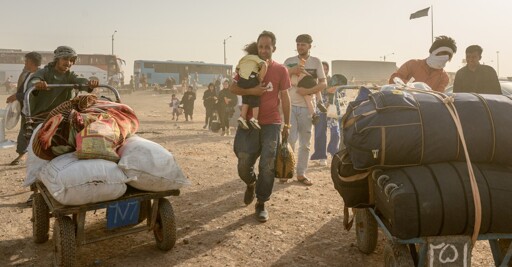Last month’s war with Israel and the United States lasted only 12 days, but Iran is likely to feel its consequences for years. The country’s intelligence services failed to prevent Israel from assassinating many top military officials, and now the Iranian regime is lashing out in all directions. It has handed down harsher sentences to political prisoners, harassed members of religious and ethnic minorities, and executed dozens of people. But one community has suffered perhaps more than any other: Afghan migrants in Iran, who number as many as 6 million by some estimates.
In the past few months, Iran has deported hundreds of thousands of Afghans—The New York Times reports 1.4 million since January—sending them back across the 572-mile border the two countries share. This process began well before the Israeli bombing campaign. Back in March, Iranian authorities warned Afghans that many of their temporary residence papers would soon cease to be valid. But the war seems to have accelerated the campaign. Iran deported more than 100,000 Afghans within a few days last month. In June alone, at least 5,000 children were separated from their parents. The security forces have haphazardly picked up thousands of Afghans and even people suspected of being Afghans. Some are legal residents who were deported before they could produce their papers. In some cases, authorities have torn up residency papers. Every day, thousands are boarded onto buses bound for Afghanistan. Both the Taliban administration and the United Nations migration officials there have complained about the sheer number of migrants appearing at the border.
[Arash Azizi: Iran’s stunning incompetence]
Deportation camps near Tehran are now filled with thousands of Afghans. Shargh, a Tehran daily, has published many harrowing reports on the deportation effort. With no time to change out of their slippers or work clothes, some Afghans scramble to get their relatives to bring them their papers before they are expelled from the country. An elderly woman told reporters that her husband, who is deaf, had lost his documents at one of the camps and is now being deported. Another woman lamented that her family had lived in Iran for 58 years and were now forced to leave the only country they knew. According to the latest instructions, only Afghans in certain migrant categories are allowed to stay. Temporary documents that once allowed others access to certain services are now void. Many Afghans have been deported before being able to collect the considerable security deposits held by their landlords (Iran’s inflation is such that renters typically put down a large lump sum as a deposit in lieu of paying a monthly rent).
Iran is justifying the mass deportations with the spurious claim that Afghans assisted Israeli operations in Iran. The authorities have paraded Afghan migrants on state television, airing their undoubtedly coerced confessions of guilt. In one clip, an Afghan migrant is shown confessing to the head of the judiciary that he filmed Iran’s air-defense systems, presumably for Israel. The authorities claim that these Afghans were paid via cryptocurrencies.
Such cynical ploys fool very few. Social media abounds with jokes about how the regime is so humiliated by Israel’s battering, all it can muster is a desperate crackdown on Afghans.
Iran has been home to millions of Afghans for decades. They are a long-standing part of Iranian society, commonly working in demanding jobs such as construction. The two countries share many cultural similarities and a lingua franca. Many Afghans even hail from regions, such as Herat, that were intermittently part of Iranian territory until the 19th century. Many more consider themselves part of the broader Iranian cultural sphere and grew up on Persian literature. Yet they’ve long been treated as an underclass. Until 2015, most Afghan children were not allowed to register in schools. The majority of Afghans has to regularly renew residence permits without any path to permanent status. Although Afghan women can be naturalized if they marry Iranians, this option is not open to Afghan men. In fact, even children born to such unions are denied status. And without status, Afghans have problems completing basic tasks, such as opening bank accounts or renting apartments.
Anti-immigrant sentiments in Iran have only intensified since the Taliban’s capture of Kabul in 2021 produced an influx of irregular migration. The Islamic Republic is thus using this moment of crisis and heightened nationalism to push a program likely to be popular. During last year’s presidential election, candidates competed by offering anti-migrant programs. One even promised to build a wall on Iran’s eastern border. The winning candidate, Masoud Pezeshkian, promised to block the borders to prevent further migration from Afghanistan. Nor is this a partisan issue. One of the very few causes that brings together many pro- and anti-regime Iranians is opposition to Afghan migration.
One conspiracy theory that has currency in anti-regime circles holds that the Islamic Republic has brought in Afghans to engineer the country’s demographics, making the society more conservative and recruiting Afghans to beef up the repressive forces. Little evidence supports this theory, but Tehran does have a history of politically using the Afghan refugees. It dispatched tens of thousands of Shiite Afghans to fight its sectarian wars in Syria and Iraq. Other anti-migrant voices invoke the familiar trope that immigrants are behind violent crimes, even though there is no evidence of Afghans in Iran committing a disproportionate share of such crimes. In late May, a young Iranian woman was killed by a taxi driver, her body left in the desert, and some Iranians tried to link the crime to Afghan migrants, even though the driver, who confessed, was Iranian.
The deportations are especially hard on Afghan women because the Taliban happens to be running arguably the world’s only regime more misogynistic than the Islamic Republic. Under the Taliban’s rule, Afghan girls are barred from studying after sixth grade, and women cannot travel or appear alone in public. Before the Taliban sent them home, more than 100,000 women were studying in Afghan universities. Some fled to Iran in the hope of continuing their education.
If Iran had a more rational immigration policy, it could use the talents of these women and others fleeing the Taliban. Many have Ph.D.s and other professional qualifications. Afghans born in Iran or those who have spent decades in the country should have been offered a path to permanent residency and naturalization. Instead, Iran’s migration policy has long been chaotic and arbitrary, and the country tolerates a sometimes shocking degree of crude racism. Not only is there almost no path to legal citizenship, but No Afghans allowed signs are known to appear at shopping centers, and some Afghans have suffered racist assaults.
Fereshteh Hosseini, an Afghan Iranian actor, appeared at the Karlovy Vary film festival last week. Donning a traditional Afghan hat, she took the opportunity to criticize Taliban rule and advocate against the mass deportation of Afghans from Iran. Hosseini is perhaps the best known Afghan Iranian in Iran, in part because she’s married to a famous Iranian film star, but her status has not shielded her from racist abuse. In response to the viral clip of her speech at Karlovy Vary, a major conservative Iranian website attacked her, accusing her of “treason.”
[Read: Afghan women have been brought back in time]
There have always been Iranians who oppose the country’s discriminatory policies and the society’s casual racism toward Afghans. Almost 20 years ago, I volunteered in southern Tehran every weekend, teaching Afghan children who were then deprived of the right to education. The classes were organized by an Iranian NGO and taught by young activists like me. In recent years, Iranian sociologists, activists, and filmmakers have come to advocate for Afghan migrants. This work has made a difference. In 2015, the regime relented and allowed Afghan children to go to school.
Some Iranians are raising their voices now. The Nobel Peace Prize laureate Narges Mohammadi has attacked the mass deportation of Afghan migrants as contradicting “humanitarian principles” and Iran’s “international obligations.” A group that tracks executions has warned about an uptick in executions of Afghans in Iran. An op-ed in Shargh criticized the “extremism” of the anti-migrant campaign and called for a more rational policy.
The Iranian expulsions are part of a global trend. Much like the United States and Europe, countries such as Iran, Turkey, Lebanon, Pakistan, and South Africa have cracked down hard on migrants. The lot of Afghans is particularly bad. In Turkey, they’ve suffered from the broader anti-migrant backlash targeting Syrians. From September 2023 to January 2025, Pakistan sent more than 800,000 Afghan migrants home. Millions anxiously remain in Pakistan. Much like those still in Iran, they are caught between the draconian rule of the Taliban and a world ever less friendly to migration.
From The Atlantic via this RSS feed


